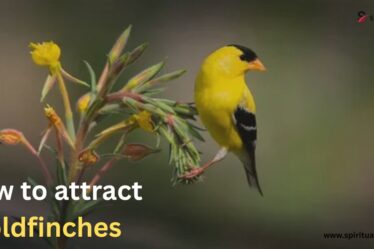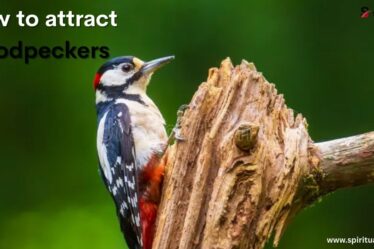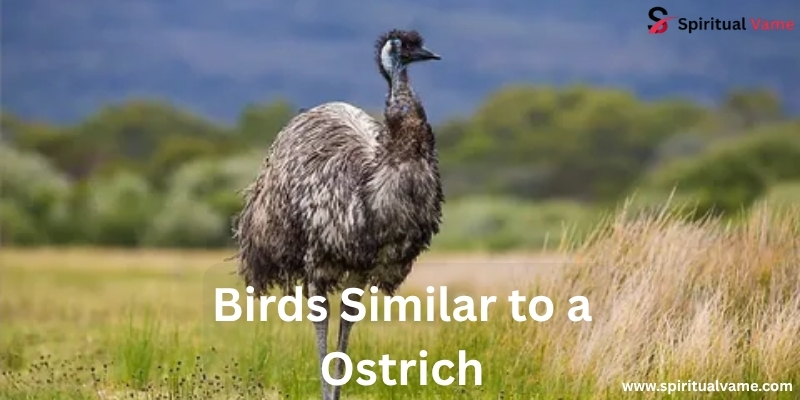
Looking for birds that look like ostriches? You’re in the right place. In this guide, we’ll explore birds similar to ostrich. These birds may not be ostriches, but they share many features. Some are tall and flightless. Others have long necks and strong legs. You’ll be surprised how close they are in looks and habits.
From Africa to Australia, nature is full of amazing birds. We’ve picked 10 birds similar to ostrich that stand out. These birds live in grasslands, deserts, and forests. They run fast and some lay huge eggs. Whether you love wildlife or just want to learn, these 10 bird similar to ostrich will catch your eye.
Ostriches and Related Birds
Ostriches are part of a group of birds known as ratites, which includes other flightless birds like the emu, rhea, cassowary, and kiwi. These birds share a common trait—they can’t fly because they lack the keel bone in their chest that flying birds use to anchor flight muscles. Instead, their strength lies in their legs. Ratites are built to run, with long, muscular legs and toes designed for sprinting across open plains, desert terrain, and dry grassland. They use their speed and power to escape predators, rather than flying away like most other birds.
Ratites are also scattered across different continents. The ostrich roams the African savanna, the emu rules the Australian outback, and the rhea strides through the plains of South America. Despite being spread across such distant lands, they all belong to the subclass Palaeognathae, which also includes extinct giants like the moa and elephant bird. The fact that these birds are similar even though they live far apart is due to convergent evolution, where different species develop similar traits to survive in similar environments. This is why birds like the marabou stork or kori bustard, although not ratites, resemble ostriches in appearance and behavior.
Ratite Facts
The word ratite refers to a flightless bird with a flat breastbone. These birds can’t fly, but they make up for it with other adaptations. Ostriches can run at speeds over forty miles per hour, while cassowaries are strong enough to defend themselves with a swift kick. All ratites are omnivorous, meaning they eat both plants and animals, and many live a nomadic lifestyle, moving across wide areas to find food. Their wings are small, but they still use them for balance and communication. During courtship, males often flap their wings or perform dances to attract females.
Another interesting trait among ratites is their unique reproductive behavior. For instance, ostriches and rheas are often polygamous, with males guarding multiple nests, while kiwis are usually monogamous, staying with one mate. Their chicks are precocial, meaning they hatch fully feathered and ready to move, unlike the helpless chicks of songbirds. Ratites also go through molting and preening, like other birds, keeping their feathers clean and functional even though they can’t use them for flight. Some, like the cassowary, grow a casque—a bony structure on their heads, possibly used for recognition or defense.
Classification
All ratites fall under the taxonomy of Struthioniformes, a large order that includes five main families. The ostrich belongs to the family Struthionidae, the emu to Dromaiidae, the cassowary to Casuariidae, the rhea to Rheidae, and the kiwi to Apterygidae. These birds are part of the broader avian class, under the phylum Chordata and kingdom Animalia. Despite the shared classification, each has its own distinct features, shaped by millions of years of evolution.
The relationships between these birds are fascinating. The ostrich, for example, is more distantly related to the cassowary than one might think. Modern genetic analysis shows that flightlessness may have evolved more than once. This challenges earlier beliefs that all ratites descended from a single flightless ancestor. Their ontology and hierarchy show that while they appear similar, each species took a unique path in evolution. Their differences in behavior, diet, and habitat reflect this evolutionary split. These differences also affect their role in the ecosystem, from seed dispersal to population control of small animals.
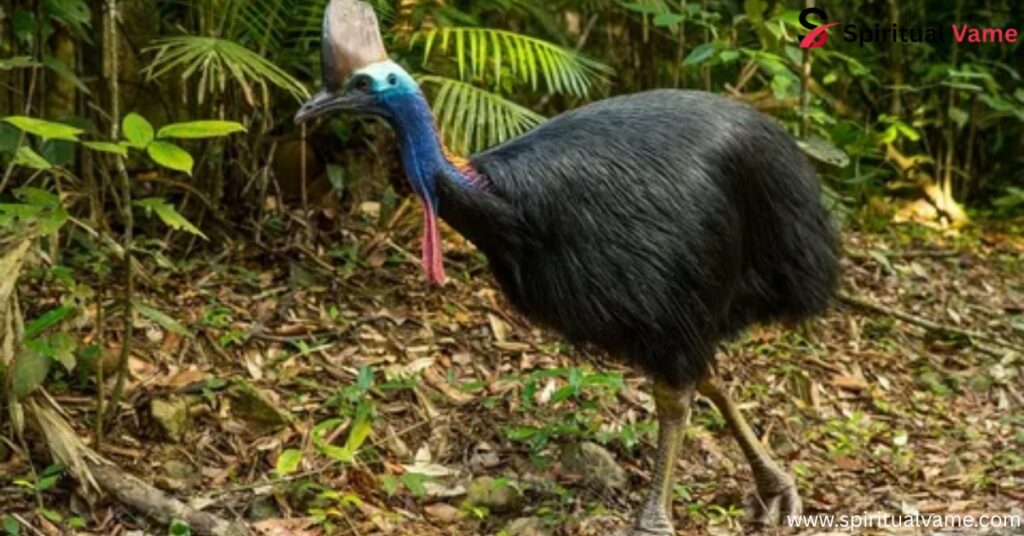
Ostrich Characteristics
The ostrich is not just the largest bird on Earth—it’s also one of the fastest land animals. It can reach up to forty-five miles per hour, thanks to its long, powerful legs. Each foot has only two toes, unlike most birds that have three or four. This helps the ostrich run more efficiently. It also has a long neck and large eyes, which give it excellent vision to watch for danger in the wide savanna. Its plumage is thick but not suitable for flight, instead helping with temperature control and camouflage.
Ostriches also show remarkable behavior. They live in groups, sometimes communal, sometimes territorial, and follow a structured mating system. A dominant male may have several females in his group and will build a shallow nesting pit in the ground. The clutch of eggs can be massive, sometimes more than twenty, and both the male and female take turns incubating them. Once hatched, the chicks are well-developed and begin to forage immediately. These traits are shared with other birds similar to ostriches, as we’ll now explore.
10 Birds Similar to Ostrich
1. Emus (Dromaius novaehollandiae)
Emus (Dromaius novaehollandiae) are the second-largest birds in the world and are native to Australia. Like ostriches, they’re flightless, with long legs built for running. Emus are also omnivorous and roam the wild outback in search of food. They belong to the family Dromaiidae, within the same Palaeognathae group as ostriches.
2. Southern Cassowaries (Casuarius casuarius)
Southern Cassowaries (Casuarius casuarius) are colorful but dangerous birds found in New Guinea and northern Australia. They have a distinct casque on their head, strong legs, and a territorial nature. They live in rainforests, and while smaller than ostriches, they are far more aggressive.
3. Southern Cassowaries (Casuarius casuarius)
Southern Cassowaries (Casuarius casuarius) are the largest birds in South America. Their gray feathers and long necks make them look like mini ostriches. Rheas belong to the family Rheidae and are known for their polygamous nesting systems and communal living.
4. Kiwis (Apteryx)
Kiwis (Apteryx) from New Zealand are small, round, and nocturnal. They might not look much like ostriches at first glance, but their skeletal structure, flightlessness, and place in the ratite family (Apterygidae) make them close cousins.
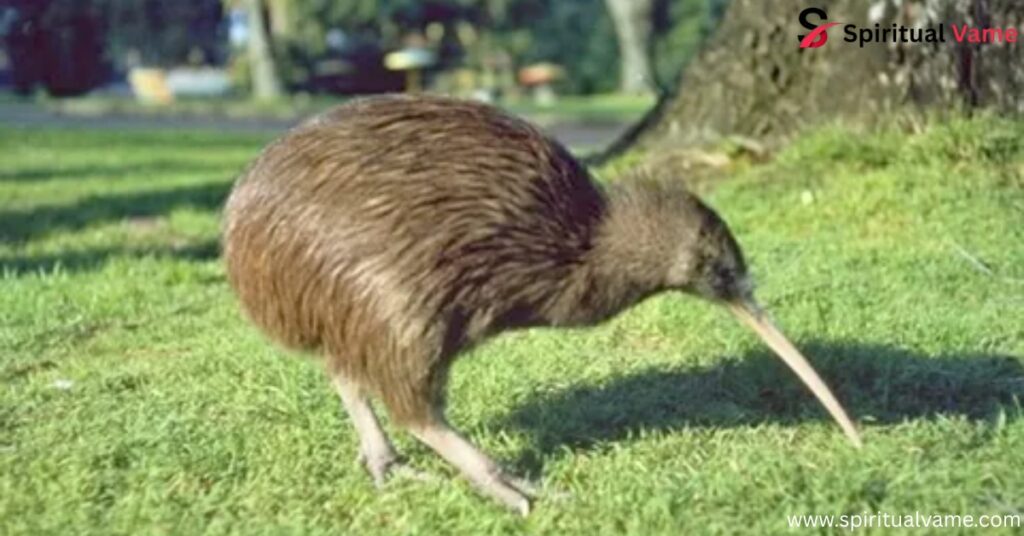
5. Marabou Storks
Marabou Storks (Leptoptilos crumenifer) live in Africa and are not ratites, but they do share some visual traits. These large scavengers have long legs, bald heads, and hang out on the ground like ostriches do in the wild.
6. Greater Flamingos
Greater Flamingos (Phoenicopterus roseus) are known for their pink color and elegant stance. Though they can fly, their body shape—long legs and neck—and feeding habits in shallow waters mirror some aspects of ostriches.
7.Trumpeter Swans
Trumpeter Swans (Cygnus buccinator) are among the largest waterfowl in North America. While not flightless, their large bodies, white plumage, and protective nature draw parallels to ostriches’ physical presence.
8. Whooping Cranes
Whooping Cranes (Grus americana) are endangered and known for their height, white feathers, and loud calls. They live in North American wetlands and show similar mating dances and long strides.
9. California Condors
California Condors (Gymnogyps californianus), native to the USA, are the largest flying birds in North America. Their massive wingspan and strong beak are very different from ostriches, yet their dominance and conservation story echo similar ecological importance.
10. Kori Bustards
Kori Bustards (Ardeotis kori) from Africa are some of the heaviest flying birds. They often walk rather than fly and forage like ostriches, showing overlapping behavior and habitat use.
Other Ratites
Besides the birds listed above, the world has seen many extinct ratites like the moa of New Zealand and the elephant bird of Madagascar. These giants once ruled their ecosystems, with some reaching over ten feet tall. Their extinction is mostly blamed on humans and habitat loss. Today’s living ratites are the last of their kind, and many are under threat. Conservation groups are now working to protect birds like the cassowary, rhea, and kiwi from facing the same fate.
Principal Terms
Ratites are a type of flightless bird with a flat breastbone. Other key terms include keel, the missing chest bone that enables flight; plumage, the feather covering of birds; precocial, describing chicks that are born fully developed; and casque, the helmet-like structure found on some birds like the cassowary. Understanding these attributes helps recognize patterns in taxonomy and the evolution of birds. All these terms are essential in classification and semantic modeling used in NLP and biological analysis.
Ostrich
The ostrich (Struthio camelus) is a bird like no other. Native to the savannas and deserts of Africa, it’s the largest living bird, standing up to nine feet tall and weighing as much as 150 kilograms. Its long legs and two-toed feet help it cover large distances quickly, making it the fastest runner among birds. Its speed can reach over forty miles per hour, which it uses to escape predators like lions and hyenas. Unlike most birds, ostriches don’t have a keel, the bone that supports flight muscles, which is why they can’t fly.
Despite being flightless, ostriches are highly adapted to their environment. Their feathers aren’t for flying but are perfect for insulation, keeping them cool in the heat and warm during cold nights. Their huge eyes—measuring about two inches across—give them great vision to scan their surroundings. They also have a powerful beak for pecking at plants, seeds, and even small animals. In terms of behavior, they live in groups and use coordinated mating rituals, where males perform dances and deep booming calls to attract females. Their eggs are the largest of any bird, sometimes weighing up to 1.5 kilograms, and their nests are often communal, with several females laying in a single clutch.
Emu
The emu (Dromaius novaehollandiae) is Australia’s most iconic bird and the second-largest in the world. Like the ostrich, the emu is flightless and relies on powerful legs to run, reaching speeds of thirty miles per hour. Emus live in a range of environments across Australia, from open forests to arid grasslands, and are highly adaptable. They eat a wide variety of food, including insects, seeds, and fruits, making them true omnivores. Their plumage is shaggy and coarse, with grey-brown feathers that help them blend into their surroundings.
Unlike ostriches, male emus are responsible for incubating the eggs. After the female lays them—usually around eight to ten—the male will sit on them for about eight weeks without eating much, relying on body fat for energy. Emus also show nomadic behavior, traveling long distances in search of food or after seasonal rains. Their family, Dromaiidae, shares many similarities with the ostrich’s Struthionidae, but their evolutionary paths diverged millions of years ago. Still, their adaptations and ecological role make them remarkably similar.
Cassowary
The cassowary (Casuarius casuarius) is one of the most unique birds on Earth, known for its vivid blue and black plumage, tall helmet-like casque, and solitary nature. Native to the tropical rainforests of New Guinea and northern Australia, cassowaries are incredibly strong and can be quite dangerous if threatened. Their powerful legs, with sharp claws, can deliver fatal kicks, making them one of the few birds considered a threat to humans.
Cassowaries are shy and mostly nocturnal, preferring to forage in dense undergrowth. They eat mostly fruits, but also insects and small animals, playing a major role in seed dispersal. Like emus, male cassowaries take care of the eggs, which are a beautiful green color, and rear the young after hatching. Belonging to the family Casuariidae, they share their flightless structure with ostriches, though they are generally smaller and live in wetter habitats. Their evolutionary path, anatomy, and behavior all show deep connections to the ratite group.
Rhea
The greater rhea (Rhea americana) is South America’s largest bird and closely resembles the ostrich in appearance and behavior. Native to countries like Brazil, Argentina, and Paraguay, rheas prefer open plains and savannas where they can use their long legs to escape predators. They stand about five feet tall and weigh up to 40 kilograms. Like ostriches, they have strong legs, small wings, and no keel, making them excellent runners but incapable of flight.
Rheas are omnivorous, feeding on plants, insects, and small vertebrates. Their mating system is especially interesting: the male digs a nesting pit, gathers eggs from several females, and takes full responsibility for incubation and chick care. This communal nesting and polygamous system is similar to that of ostriches. Belonging to the Rheidae family, rheas show many classic ratite traits but also have their own unique behaviors shaped by the South American environment.
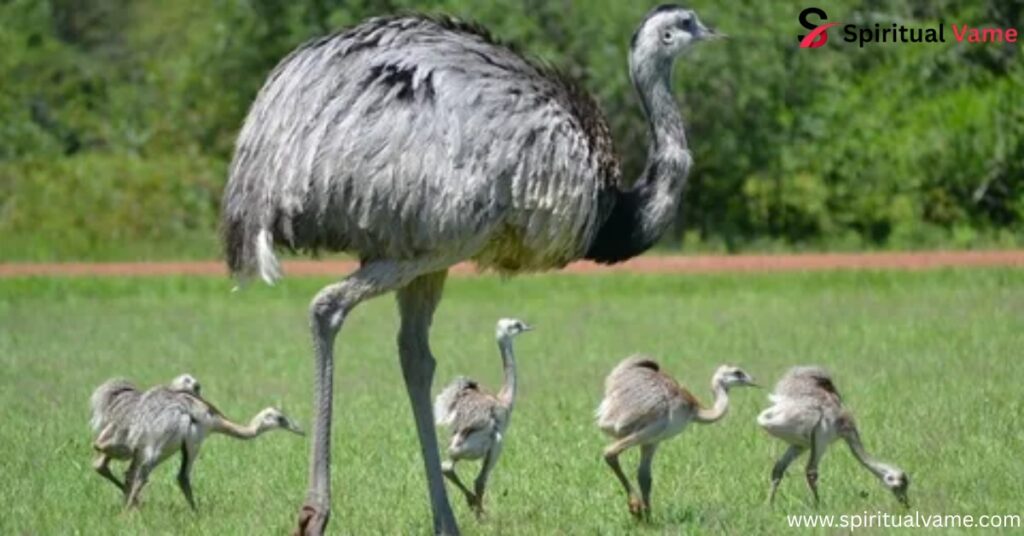
Kiwi
The kiwi (Apteryx) is a small, round bird from New Zealand, known for its unusual shape and nocturnal lifestyle. Though it’s much smaller than the ostrich, it’s still part of the ratite family. Kiwis have poor eyesight but a keen sense of smell, and they use their long, sensitive beak to sniff out insects, worms, and seeds. Unlike other ratites, they live in forested habitats and dig burrows instead of building nests.
Kiwis lay very large eggs relative to their body size—sometimes up to one-quarter of their body weight. The male kiwi often incubates the egg alone, hiding it in a burrow for nearly 80 days. With soft feathers, no tail, and tiny wings, kiwis show just how diverse the ratite family can be. They’re solitary, secretive, and unfortunately endangered, mainly due to habitat loss and invasive predators. Still, they share the same evolutionary heritage as ostriches and provide insight into how different environments shape bird behavior.
Marabou Stork (Leptoptilos crumenifer)
The marabou stork (Leptoptilos crumenifer) might not be a ratite, but its large size, long legs, and terrestrial habits give it an ostrich-like appearance from afar. Found across sub-Saharan Africa, this massive bird can grow over five feet tall with a wingspan exceeding ten feet. While it can fly—unlike the ostrich—most of its time is spent walking across grasslands, savannas, and urban dumps in search of food. Often called the “undertaker bird” because of its bald head and cloak-like wings, the marabou plays a vital role as a scavenger, feeding on carrion and waste.
Despite their grim nickname, marabou storks are essential to ecosystem health, as they help clean up carcasses and prevent disease spread. They also eat fish, frogs, and even small birds. Their bald head is an adaptation that helps them stay clean while feeding. Though not technically in the ratite group, their behavior, habitat, and stature place them in a similar ecological niche. With strong legs and a slow, deliberate gait, they often remind onlookers of ostriches as they move through open land.
Greater Flamingo (Phoenicopterus roseus)
At first glance, the greater flamingo (Phoenicopterus roseus) doesn’t seem much like an ostrich. But look closer—its long legs, neck, and terrestrial lifestyle mirror many features found in flightless birds. Native to parts of Africa, Europe, and Asia, this elegant bird thrives in wetlands, lagoons, and shallow lakes, where it feeds by filtering water with its specially adapted beak. Flamingos stand up to five feet tall and live in large, communal flocks, sometimes numbering in the thousands.
Their distinctive pink plumage comes from the carotenoids in their diet, mainly small crustaceans and algae. Unlike ratites, flamingos do fly and migrate, but their wading behavior, social nesting, and unusual mating dances resemble some traits seen in ostriches. Their legs and posture are especially similar when viewed at a distance. Flamingos also lay one egg at a time, with both parents sharing incubation duties. While not evolutionarily close, the similar adaptations to marshy environments and upright posture make them a surprising ostrich counterpart.
Trumpeter Swan (Cygnus buccinator)
The trumpeter swan (Cygnus buccinator) is North America’s largest native waterfowl, with some individuals weighing over 30 pounds and stretching more than five feet in length. Found across Canada and the northern United States, this migratory bird shares some structural and behavioral similarities with the ostrich, such as long necks, strong legs, and a preference for ground nesting. Though they fly, their massive bodies and plumage give them a grounded, stately presence when seen up close.
They are primarily monogamous, forming long-lasting pair bonds and raising their young in quiet wetlands. Their powerful calls, which resemble a trumpet, can travel long distances and are used for communication and territory defense. While they belong to a completely different bird order, the trumpeter swan’s upright posture, large size, and nesting behavior show how different bird lineages can evolve similar traits based on environmental pressures—a classic example of convergent evolution in avian species.
Whooping Crane (Grus americana)
The whooping crane (Grus americana) is another North American bird that bears a striking resemblance to the ostrich in terms of height, leg length, and foraging behavior. Standing nearly five feet tall, it’s the tallest bird native to the United States. Once on the brink of extinction, with just fifteen individuals left in the 1940s, aggressive conservation efforts have helped revive their population. These majestic birds are now primarily found in wetlands and plains during migration between Canada and Texas.
Whooping cranes are monogamous, and their elaborate mating dances involve leaps, calls, and wing displays that help form and strengthen pair bonds. Their diet consists of aquatic plants, small animals, and grains, showing their omnivorous tendencies. Though they fly long distances during migration, their upright stance, courtship, and territorial behavior on land closely mimic many ostrich traits. Their role in the ecosystem, as well as their ongoing struggle for survival, makes them a symbol of avian conservation and biodiversity preservation.
California Condor (Gymnogyps californianus)
The California condor (Gymnogyps californianus) is a symbol of survival and one of the rarest birds in the world. With a wingspan reaching nine and a half feet, it’s the largest flying bird in North America. Although it can soar high above mountains and canyons, it spends much of its time perched or walking on the ground, which highlights its similarity to ostriches in terms of terrestrial habits and social behavior. Once reduced to just 27 birds, massive recovery programs have helped bring them back from extinction.
Condors are scavengers, feeding on large carcasses and playing a key role in the ecosystem. They prefer rocky cliffs and open terrain for nesting, using their sharp beak to tear flesh. Their plumage is black with a distinctive white triangle on the underside of their wings, and they possess a bald head—an adaptation for hygiene. While not a ratite, their lifestyle, size, and ecological function bear notable parallels to ostriches. Their story is a powerful lesson in conservation, showing how determined efforts can bring species back from the edge.
Kori Bustard (Ardeotis kori)
The kori bustard (Ardeotis kori) is often called the heaviest flying bird, though it rarely takes to the air. Found mainly in the grasslands and savannas of southern Africa, this ground-dwelling giant spends most of its life walking, feeding, and mating on foot. Weighing up to 40 pounds and standing over four feet tall, the kori bustard’s massive size and terrestrial habits make it closely resemble the ostrich. In fact, many safari-goers confuse the two when spotting them from a distance.
Kori bustards are omnivorous, feeding on insects, lizards, seeds, and even small mammals. Males are significantly larger than females and engage in dramatic courtship displays, puffing out their necks and booming deep calls. Though they can fly if threatened, they prefer to stay grounded, walking slowly as they forage. Their preference for open habitats, solitary nature, and strong legs place them right in line with ostrich-like species. The kori bustard belongs to a different order, but it remains one of the most striking land birds of Africa, both in size and behavior.
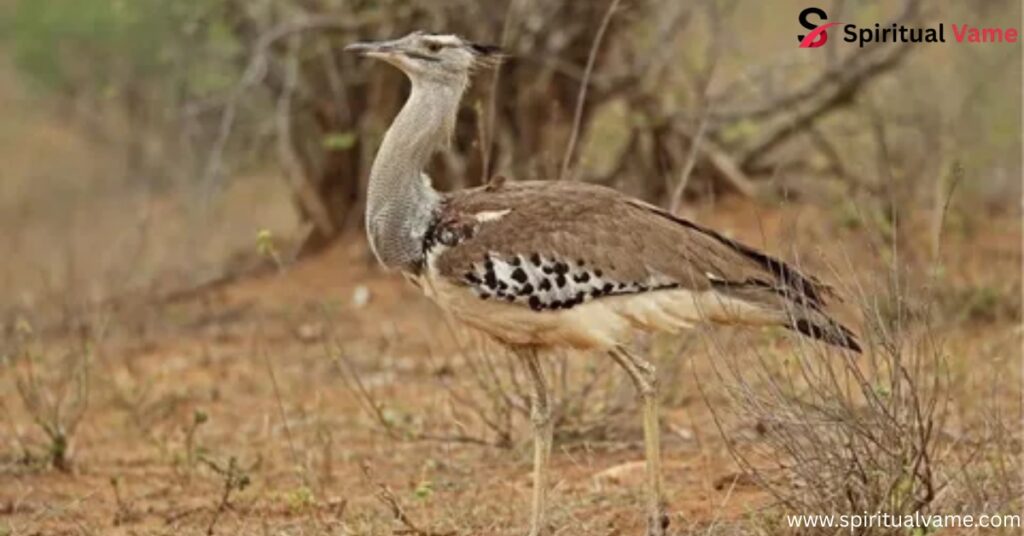
Conclusion
When it comes to birds that resemble the ostrich, the natural world offers a fascinating mix of species that echo its size, shape, and behavior—whether they’re fellow ratites or unrelated birds that evolved similar features. From the towering emu of Australia to the stealthy kiwi of New Zealand, and even the graceful trumpeter swan or the scavenging California condor, each bird tells a story of adaptation, evolution, and survival in its unique habitat. Some thrive in grasslands and deserts, others in wetlands or forests, but all share traits that remind us of the ostrich—like long legs, powerful beaks, and a mostly terrestrial lifestyle.
Whether classified within Struthioniformes, Casuariiformes, or found far outside the ratite family, these birds reveal the complex taxonomy and biodiversity of the avian world. They highlight how different species can follow similar evolutionary paths despite being spread across continents—from the Southern Hemisphere’s open plains to the rugged coasts of North America. Understanding these parallels deepens our appreciation for how life adapts, survives, and continues to amaze us with both its diversity and its uncanny similarities.

